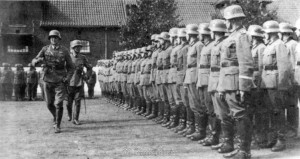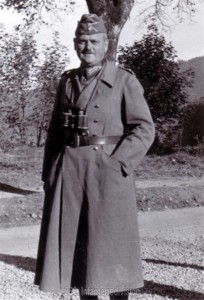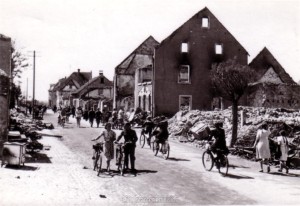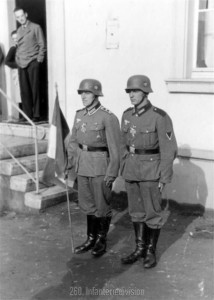During the period 26th August – 01st September 1939, the 260th Infantry Division was established as a 4th wave unit in Ludwigsburg. The division counted 491 officers, 99 civilians, 2.165 non commissioned officers and 12.264 soldiers. It had a total strength of 15.019 men. Lieutenant General Hans Schmidt, born in Ulm, became the first commander of the division.
His first formal orders were as follows:
As of today I will take command of the Division. Our troops and units are re-established. War veterans, that bravely have defended their country with their life stand in line with our youth that will follow this example. We will use our full energy to finish our training and skills so we will be ready to take upon any given task. Following the oath to our colors, we will fulfill our duties to the ultimate end.
Schmidt, Lieutenant General
During Germany’s assault on Poland between 1st and 9th of September, the division was deployed to Muensingen training area. On the 8th of September, the commander received the deployment orders for his division at the Army command 7 in Calw.
Between 9th and 10th September, the 260th Infantry Division was ordered to the western front and deployed there. Until 19th of April, it took positions on the upper Rhine River both sides of the towns Muellheim and Neuenburg am Rhein. The Division Command Post was located in Badenweiler. Throughout the time, the men were busy building combat positions and going on reconnaissance. During one of these venturesome missions, a French flag was captured by men of the Infantry Regiment 470. This was honored with the first Iron Crosses 2nd class.
On the 8th of January, French troops opened fire on positions of 2nd battalion, Infantry regiment 470. The civilian worker Eberle, member of a construction unit, suffered a head shot and died. He was the division’s first victim.
Beginning April 20th, 1940 the division started to conduct training in the area of operations of the western front near Villingen. Road marches by night to Tuebingen and railroad deployments to Reutlingen, Metzingen and Kirchentellinsfurt were executed. In Reutlingen, part of the Division HQ was posted at Ypernkaserne. On Mai 20th, the structure of the 2nd Army command changed: together with 298th and 162nd Infantry division, the 260th Infantry Division became the XXXXIInd army corps.
After railroad transport to the Eifel area (between 21st and 23rd May, near Erdorf and Bitburg) the assault into Luxemburg commenced. The German forces advance throughout the little country via Dasburg, Clerf and Allerborn (23rd – 25th of may). The Division crossed Belgium passing the cities Graide – Our – Louette St.Pierre – Willerzie. The King of Belgium signed the capitulation papers on 28th of May 1940. After the division was brought to halt near the Maas river crossing close to Monthermé, it became the reserve of the XIIIth Army Corps.
On 30th May 1940, the unit was subordinated under the 12th Army Command. With that change, the direction of assault changed form West to South. The following day, the 31st of may 1940, orders were given to mark of all vehicles in the Division with an own unit symbol. This measure became necessary to divert the different vehicles that used the same assault routes. As unit crest, the “Hoernle” was chosen. It was a modification of the old symbol of the Württemberg kingdom. It showed 4 horns bended to the left. It had a length of 19 cm and was 2,5 cm wide. It had to be put on all vehicles at the front and rear.
On 01st of June 1940, the deployment north of the Aisne River began. The division crossed the Maas River near Monthermé. Its HQ was located at Arnicourt Castle near the city of Lonny. The crossing of the Aisne River was prepared near the city of Rethel. Artillery regiment 260 (without 2nd detachment) and Engineer Battalion 653 were subordinated to 17th Infantry Division to support the attack and to build the bridgehead near Château-Porcien. The soldiers of 2nd detachment / AR 260 were subordinated under the 21st Infantry division which fought also in the nearby area. The men had to fight not only the French but also the heat. They found little water but lost of vine and Champaign. The battle to break through the French Aisne front took place between the 09th and 13th of June 1940. The division had to mourn about heavy losses when it crossed the Aisne River. The reconnaissance squadron 260 fought near the city of Machault and forced the breakthrough in the Suippe area.
Mid-June 1940 the Division took part in chasing French units throughout the Champagne: from Givry to Revigny, over the Rhine-Marne-Canal, on both sides of Côte d’Or over the Langres – Dijon plateau (Nuits St.Georges – Beaune – Chagny). On the 21st of June, a parade was conducted in Dijon with the Division commander. On the 22nd of June, the cease fire was officially announced.
By the end of June the Division occupied the city of Dijon. Its main task was to secure the line of demarcation from Bourbon-Lancy near the Loire River over Paray-le-Monial at the Canal du Centre – Montchanin – Chalons-sur-Saône – Chaussin. The HQ was at Château de la Verrerie in Le Creusot. On June 30th, the division was subordinated under the XXVth Army Corps.
Until September 11th 1940, the 260th ID was deployed as occupying force in France. The area of operations was Belfort (HQ at the old fortress) – Montbeliard – Delle (close to the Swiss border) – Morvillars. During this period the soldiers had to keep up their skills by continuous training. On August 24th, the new higher HQ was the XVIIIth Army Corps.
Subordination changed two more times: on 14th September under XXXXVth Army Corps and on 15th October under XXVIIth Army Corps.
Beginning May 4th, a leave ban was ordered, on June 22nd a radio message from 1st Army command arrived: “the 260th Infantry Division will be deployed to the eastern front!” On this fateful day, operation Barbarossa began – the German invasion of the Soviet Union. Between June 30th and 3rd July 1941, the division was removed from the area of Le Creusot. The 215th Infantry Division took over the sector. Via railroad transport, the units were transferred from France throughout Germany to Poland. The unloading happened at Mordy, close to the city of Siedlce. Afterwards a march towards the Russian border north of Brest-Litowsk was carried out.
Subordination under the XXXVth Army Corps followed. The assault towards the Beresina River began. Fast marches of 50 – 70 kilometers daily via Baranowitschi to an area west of Bobruisk were the result. The Division was used south of Bobruisk. The division (IIIrd / Infantry Regiment 470) was partly deployed on trucks to fight guerrillas near Lubany. On July 13th, the Division was subordinated under the XXXIIIrd Army Corps. It was now the connecting unit between the Army Groups South and Center.
Throughout the period July 19th and August 08th 1941 the division was involved in heavy fighting south of Bobruisk. During the tough and bloody battle near the cities of Romanischtsche and Ugly on July 24th 1941, 51 attacking Soviet tanks were destroyed. The Division lost 92 men, 510 were wounded.
Beginning August 9th, 1941 the Division crossed the Beresina River south of Bobruisk on pontoon bridges built by engineers and headed towards Slobin. The left neighbor was the 267th Infantry division; the 134th Infantry division followed the 260th. South of Slobin, a bridgehead over the Dnjepr River was established after fierce fighting. On August 18th 1941, the Division was subordinated under the 13th Army Corps.
Until the end of August, the 260th followed Soviet Forces passing Gomel. They conducted raids through the cities of Gorodnya – Dubrovnoye – Tschernisch and finally Kisselewka. The city of Gomel – mostly wooden houses – was completely destroyed during the battle. The division entered the town on 22nd of August. On August 28th, the Ukrainian border was passed.
On 24th August, the attack southwards of the 13th Army Corps with 3 divisions began. Lieutenant General Schmidt ordered on September 01st to cross the Desna River on both sides of Kisselewka (east of Tschernigow). Infantry Regiment 470, later reinforced with units of Infantry Regiment 480 established a bridgehead on both sides of Wibli at 17:00 Hrs. During the intense fighting at this bridgehead, Kiew was encircled. On this day, the battle for Tschernigow began as well. Infantry Regiment 470 formed another first bridgehead over the Desna here.
Regiment 470, later reinforced by Infantry Regiment 480 create a bridgehead on both sides of Wibli around 17:00 hours
The 5th Company, Infantry Regiment 470 under the leadership of Lieutenant Hans Helmling, was the first unit in the area of thr Army Group that had crossed the Desna River. During the fierce fighting over the bridgehead near Wibli, the encirclement around Kiev was closed. On September 1, 1941 the fight for the city of Chernigov began. On September 2, strongest Russian artillery fire was hitting on Wibli.
The situation stabilized on 03. September. Soviet troops attacked the bridgehead fifteen times and were thrown back just as often.
On September 5, the troops of the 5th Soviet Army retreated. On this day the 260th ID was subordinated under the XXXXIII. Army Corps.
On September 9, 1941, the division reached Janowka, a small village south of Chernigov. This was the southernmost place of the advance. On September 12, the division was again subordinate under the XIII. Army Corps. The battles of the past few days cost the division 515 killed, 600 dead horses and more than 4,000 other casualites.
On September 14, 1941, the regrouped 260th Infantry Division marched via Chernigov and Starodub (22.09.) to the area southeast of Roslavl. Lieutenant General Schmidt was awarded the Knight’s Cross in Unecha on 23 September.
The constant fighting ended on 26 September in Kiev with the larges encirclement battle in history. More than 660,000 Soviet soldiers died here or were taken prisoner because Stalin had stubbornly held on to the city and ordered a rigid defense (his adversary was also to commit this mistake 3 years later). On September 26, 1941, the first frost also announced the winter.
Between September 28, 1941 and October 3, 1941, the division made its breakthrough through the Stalin Line. In the north, the defensive battle took place at Jelnja. The break through the upper Desna position and formation of a bridgehead at Star Chotmirowka followed.
On October 2, 1941 began the „Operation Typhoon“, the German assault on Moscow. Most German soldiers showed a lack of understanding, the units were awaining the harsh Russian winter.
In the period from October 03, 1941 to October 11, 1941 they came across Bolwa and Ugra, the airfield Vorotynsk was reached quickly. On October 8, the 260th Infantry Division was subordinated to Army High Command 4 (Generaloberst von Kluge). The division was ordered to storm the Oka Bridges south of Kaluga.
On October 11, 1941, the city of Kaluga, which has 90,000 inhabitants, was captured. The 17th Infantry Division penetrated after several days of fighting from the west, the infantry regiment 470 entered (after two river crossings within 24 hours) from the south. Soldiers of the 7th Company / Infantry Regiment 21 and men of the 470 Infantry Regiment shook hands at the Oka Bridge on the southern edge of Kaluga.
On October 13, 1941, then began the assault against Moscow via Anashuja (division command post on 17.10.) – Ssaschkino (nocturnal raid on parts infantry regiment 470) – Petrishcheva. The division had to turn off to the southeast. Russian forces were thrown back across the Oka on either side of the village of Alexin. The division was deployed along the Oka from Alexin to Tarussa. There was a replacement by the 52nd Infantry Division, the 260th ID led a march in the staging area on both sides Gosteschewo (replacement by 17th Infantry Division) to attack on the Protwa through. The right neighbor was the 52nd Infantry Division, left neighbor the 137th Infantry Division. The formation of a bridgehead on both sides of Kremjonki (Kremenki) was achieved.
On October 13, „Rasputitsa“ began, the feared mud period that made advancement almost impossible. The 4th Soviet Army was ordered to retake Kaluga at all costs. On October 22, 1941, the 470th Infantry Regiment attacks Alexin.
On October 30, 1941, the division handed over the section to the 52nd Infantry Division. – it was attacked by the 60th Siberian Rifle Division. There were fierce battles on the Protwa. They started digging trenches in Kremjonki (Kremenki) bridgehead. The battles for the Browna section were followed by the attack on Browna and his capture on 03.11.1941. A 5-minute fire raid was too short here, so there were own losses in the staging area. Nevertheless, an advance to Pawlowdska succeeded (15 km west of Sserpuchow). The advance ended about 90 kilometers southwest of Moscow. On 06.11.1941 the divisional command post was located in Lgowo, the easternmost point of the advance.
Between 14 November 1941 and 15 December 1941, the defensive battle took place in front of Moscow, at which the division as part of the XIII. Corps participated.
From 14.11.1941 the Soviet armed forces took over completely the initiative. Operation at the Protwa (left neighbor 268th Infantry Division, right neighbor 52nd Infantry Division). In the bridgehead Kremjonki (Kremenki) fierce defense battles rage.
The 16th of November was the climax of the crisis reached: The 2nd battalion of the Infantry Regiment 480 consisted of only 134 soldiers, the IInd Battalion of the Infantry Regiment 470 practically no longer existed. The soldiers were stuck in holes without winter clothing, without gloves and warm boots in the open.
On 30th November, INfantry Regiment 480 only had a combat strength of 546 men.
On 14 November, 3 Russian rifle divisions, a cavalry division, a motorized brigade and a half tank division attacked the positions of the 260th ID. The frostbite outbreaks are huge. In the six weeks between October 16 and November 30, the division lost 334 dead, 1,181 wounded, 50 missing, and 811 sick.
On 15.12. showed the thermometer – 31 degrees Celsius !!! The Russian troops broke through that day, on the German side were 6 divisions which, however, had an actual strength of only 2 divisions.
The Soviet attacks shook the front on 16 December 1941. In the HKL of the adjacent 52nd Infantry Division tanks and infantry had collapsed and could not be pushed back.
The 260th ID was in defensive battles south of the Protva (Troitzkoje – Gosteschewo), an evasion to the west became necessary. This was followed by a shift to a divisional width to the south on 16 and 17.12. Each regiment received 150 men (partially unarmed). On 18.12. 12 T34 tanks and 2 heavy battle tanks, presumably KV1, broke through the main battle line and were destroyed.
The crazy private in Berlin ordered on 16 December: „Nobody steps back“
December 21st, 1941 – January 21st, 1942
Defensive combat between Protwa and Ugra. Withdrawal fighting near Aulowo – Walkowo.
3rd / Infantry Regiment 470 is surrounded, relief by 2nd / Infantry Regiment 470 and 1st SS-Regiment 4.
Russian forces break through near Tschausoso und Altuchowo The Division is surrounded
268th Infantry Division frees a way south towards Nedelnoje. On December 31st, 1941 Lieutenant General Schmidt becomes commanding general IX. Corps, Colonel Hahm takes command. Evasion through a constriction near Nedelnoje. Further evasion battles from Frolowo, Kondrowo to Ostroshnoje.
January 22nd, 1941 – January 27th, 1942
Combat on both sides of Ostroshnoje. Tank Hunter Squad 559 with 100 soldiers becomes subordinated to Infantry Regiment 470. Soviet forces attack the division on a daily basis. Major Baur, Commander Infantry Regiment 470, receives a shot in the stomach, Major Schütz takes command.
On January 26th, 1942 Soviet forces (30 soldiers) penetrate Grebnewo. These troops are destroyed by the last divisional reserve (one NCO, 9 Soldiers, 1 machine gun and a few soldiers from Infantry Regiment 470). Evacuation of the positions on order on January 27th, 1942. The actual strength of Infantry Regiment 470 constitutes of 105 soldiers!
January 28th, 1942 – March 06th, 1942
Winter battle near Juchnow. Defense along Ugra River near Kolychmanowo.
Preparation of Ressa-Ugra-position on both sides of Raljaki along the taxiway to Juchnow. Evasion into new position.
May 11th, 1942
Promotion of Major General Hahm.
March 07th, 1942 – March 07th, 1943
Defensive combat within the Winter positions west of Juchnow, the Division is based in fixed Winter positions along Ressa and Ugra. Reconnaissance patrols are conducted on both sides, combat recon is supposed to capture prisoners. Large partisan units, 100 kilometers west threaten the divisional support, the division support units have losses as a result of battles with partisan units.
January 30th, 1943
Promotion of Lieutenant General Hahm.
February 02nd, 1943
Capitulation of the German 06th army in Stalingrad. This is the turning point of world war II
March 07th, 1943 – March 18th, 1943
Abandonment of a one year held front, the forces delay from successive positions to the West in direction of Jelnja. Opposing forces apply aggressive direct pressure, heavy losses on both sides.
The so called „Buffalo movement“ ends after 125 kilometers on March, 18th, 1943 in the „Buffalo position“ between Buda and Djuki.
March 19th, 1943 – August 07th, 1943
After heavy fighting in the first few days, the Buffalo position is further strengthened. The front runs from Kamenka -Wesselucha – Sslusna – Chotilowka – Taschtschilowo – Lasinki.
Opposing forces conduct less operations and fortify their positions as well. Both sides conduct combat reconnaissance. The front units are moved back and forward, the Division Command Post is located in Uspech.
The normal course of life along the front is mostly filled with training.
On June 30th, 1943 the divisions war diary closes with the words:
„Quiet night, all combat patrols return without enemy contact. During the day, enemy movement and harassing fire are more heavy on the right regimental section the rest of the divisional front.
After one week of interruption, the enemy continues harassing fire on the railway near Radki.“
After this entry, the divisions war diary ends!
The following information derive from survivors memories.
August 07th, 1943 – September 21st, 1943
Start of large Soviet offensive operation. The division must give up the buffalo position and delay from successive positions under heavy losses. The new positions are called as follows:
-Barbarossa-Position
-Ssnopot-Position
-Schuiza-Position
-Desna-Position
-Easter-Position
September 22nd, 1943 – End October 1943
After giving up the Easter-Position the division tries in the western rear battle area to carry along the complete material carrying out extreme movements. Vehicles and horses, using shuttle traffic, are stressed to the outermost.
Final destination of this movement is the Pronja-Position along the Pronja River between Tschaussy and Asaritschi (23 km south). Attempts to break through by Russian troops are stopped with grimly close combat and changing success.
Lieutenant General Hahm is sick on leave (he will not return), he is represented by Colonel Dr. Bracher.
End October1943 – 28. February 28th, 1944
On November 09th, 1943 Major General Schlüter takes command of the division. After the situation calmed down a little, the battle positions are fortified. The Division Command Post is initially located in Ussuscheck, later in Dubrowka. The rear area includes the cities Stary, Bishow and Mogilew. Christmas and New Years Eve are spend without major disruption. January and February are calm as well, the Division can reorder and train the troops. Both sides continue to scan each other in defensive positions. The previously destroyed Regiment 470 is set up again.
March 01st 1944 – May 20th, 1944
The Division exchanges its section with 31st Infantry Division it becomes the right wing of 4th Army and with that joint unit to 9th Army. The Division Command Post is located in Judino. The main front is further fortified and combat patrols are engaging Soviet forces. Thaw begins, this denies any large size movement. The Division Commander, Major General Schlüter, is heavily wounded on his way home on April 21st. He looses one arm.
His successor is Major General Klammt. He arrives on May 10th, 1944.
Mai 21st, 1944 – June 24th, 1944
The Division is moved by rail transport to the area Orscha – Gorki – Mogilew in exchange for 56th Infantry Division.
It’s staff is now located south of Schischewo, later in Krassulino-Jurowka.
Assigned along the main front now are:
110th Infantry Division – 260th Infantry Division – 25th Mechanized Infantry Division – 78th Assault Division (the last 3 Divisions are part of XXVII army corps)
June 25th, 1944 – June 30th, 1944
Retrieve over multiple positions rearward of the Dnjepr River as a result of heaviest fighting. Opposing forces breakthroughs near Orscha, the majority of the Division crosses the Dnjepr River near Kopys and Kopistza on June 26th.
Drut River is crossed on June 30th near Teterin.
July 01st, 1944 – July 06th, 1944
Crossing of the Beresina River. In the night of June 02nd, the Division gathers for the last time behind the Beresina River, it’s combat power is 2.000 Men!
Withdrawal in a moving encirclement (together with rest of 78th Assault Division, 267th Infantry Division, 25th Mechanized Infantry Division and the Infantry Regiment 199 „Regiment List“).
Soviet forces attack from different sides and by air. The Division Commander conduct a last meeting near Tscherwan. Orders to escape to the West are given after all heavy weapons are destroyed and desperate attempts to outbreak had no success.
July 07th, 1944 – July 09th, 1944
The encirclement is cleared 35 km east of Minsk by Soviet forces.
The remaining soldiers of the Division march into captivity.
Human tragedies happen during the march. Hundreds of soldiers die in consequence of injury, dysentery and weakness.
The 260th Infantry Division does not exist anymore!




